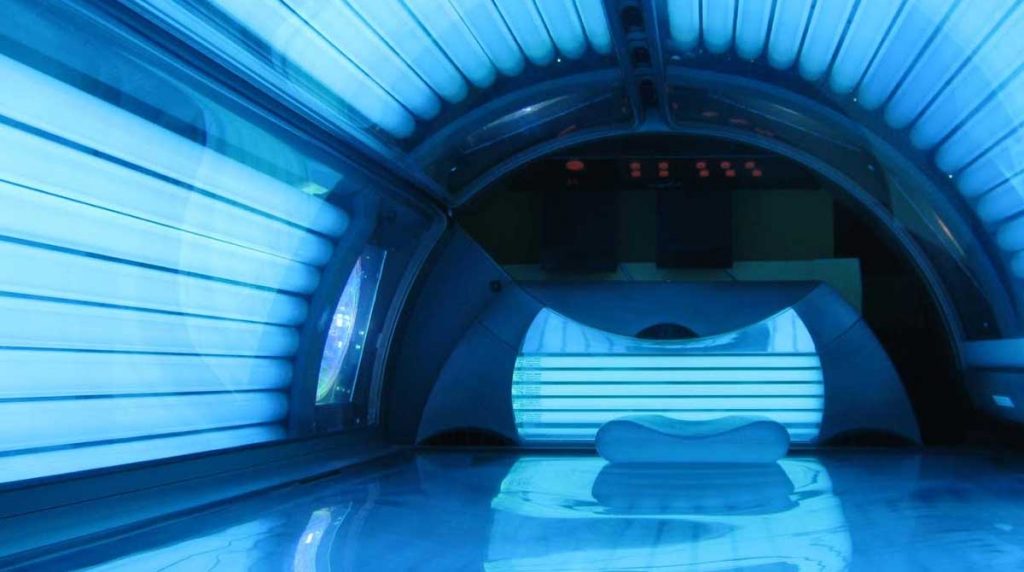Last updated on May 17th, 2021 at 08:43 am
Why do I itch so bad after the tanning bed? What can I do to prevent the tanning bed rash from happening and how can I stop it if I already have it?
Tanning beds are the fast lane to getting a perfect tan for people who can’t bask for hours under the sun. The bed uses UV bulbs to mimic UV rays the sun sends our way. These UV rays will force your skin to generate more melanin hence the darker tan.
Since its UV rays that are responsible for giving people sunburns, it’s not unheard of to get a tanning bed rash every now and then.
How Does the Tanning Bed Rash Happen?
The allergic reaction to a tanning bed has a couple of causes:
- Dry skin: The tanning lamps naturally burn moisture from your skin as you tan. If you started with dry skin, your skin cells will react to the scorching effect with itchy hives, bumps, and scaly patches
- UV overexposure: Your skin cells can deal with a fair amount of UV rays. However, if you overexpose yourself, portions of the cells will be damaged and react by creating a rash
- Allergic reaction: Allergic reactions to tanning beds are uncommon. They happen when you react with tanning lotions, oils or the product used to wipe down the tanning bed
What Does Tanning Bed Rash Look Like?
The hives from a tanning bed are hard to miss. They are red or white itchy bumps on your skin. They are inflamed and generally uncomfortable regardless of where they are. This means even tanning bed rash on buttocks is hard to miss even though you won’t see it.
Tingle tanning lotion is an alternative to tanning beds and sprays tanning. You can check out some of the best tingle tanning lotions here.
How Long Does Tanning Itch Last?
A tanning itch will fade away in under five days especially if you don’t overexpose yourself to the sun or go back into a tanning bed.
Check this too: What Is the Best Tanning Lotion for Tanning Beds
You should also refrain from scratching the itch. This could break skin leading to infection. If your hives start oozing pus and you have a fever, seek medical attention immediately.
Home Remedies for Tanning Bed Itch
Since a tanning bed itch goes away on its own, the home remedies you use can only but alleviate the discomfort. The itch from the rash is distracting and scratching it is disastrous. Here are some things you can do to combat the rash.
- Stay off the sun: Extra exposure to the sun will increase the effects since your skin will soak in more UV. Wear loose-fitting clothes to cover most of the skin and wear sunscreen that has a 30 plus SPF.
- Apply aloe vera: Aloe vera cream is a great way to soothe the itch. You can also use any available antihistamine cream to alleviate the rash in case it is due to allergic reactions.
- Soak in a warm bath: A lukewarm bath mixed with colloidal oatmeal is a great way to manage your itch.
If the above home remedies don’t cure your tanning bed rash in under five days, talk to a doctor for a stronger hydrocortisone cream or antihistamines.
How to Stop Itching from Tanning Bed
Here are some things you can do to avoid that nagging rash after tanning.
- Go to reputable tanning salons with well-maintained tanning beds
- Wipe your tanning bed with hypoallergenic wipes before lying down
- Avoid exposure to the sun for a day or two after getting from the tanning bed
- Drink a lot of water and use a good lotion before tanning to keep your skin hydrated
Don’t forget to use tanning nipple covers to protect your nipples as they are more sensitive to UV rays.
Tanning beds are a great alternative to people who don’t have access to the sun or cannot spare enough hours to bask. However, you should steer clear if you or your family members have a history of skin cancer as the risk factors are heightened.
Check this too: What Do You Clean a Tanning Bed With

